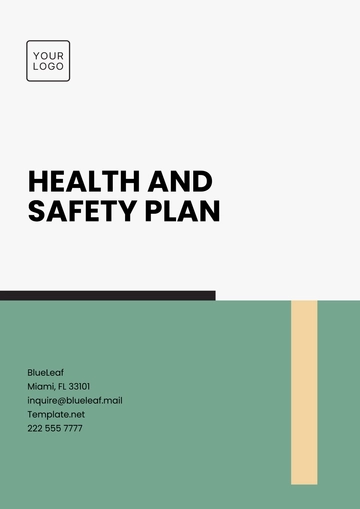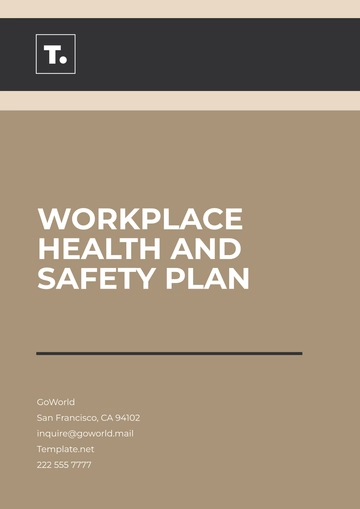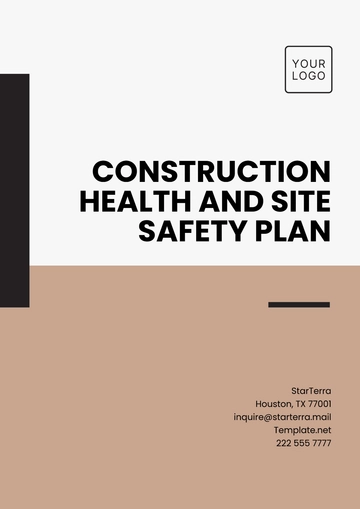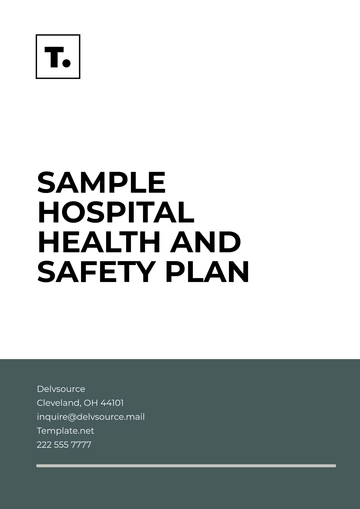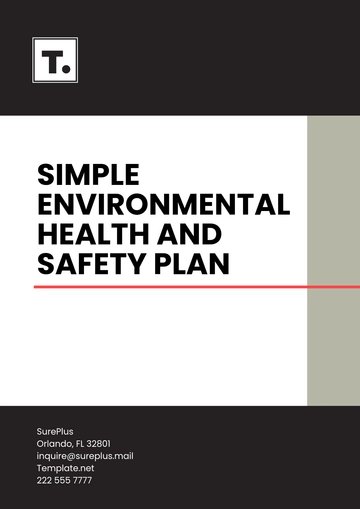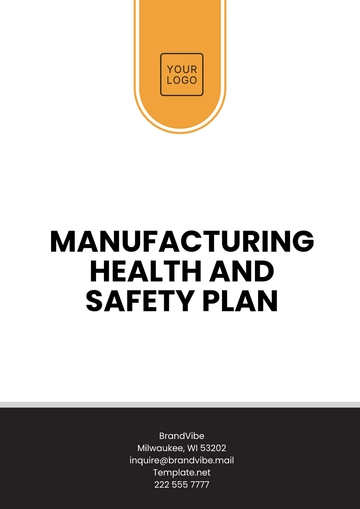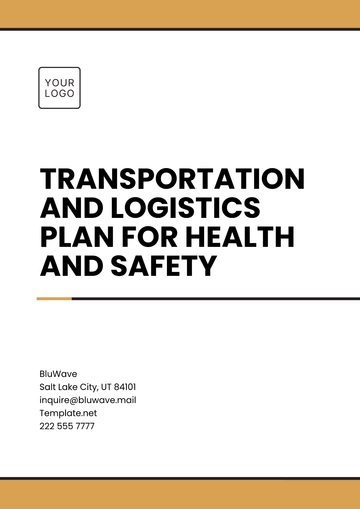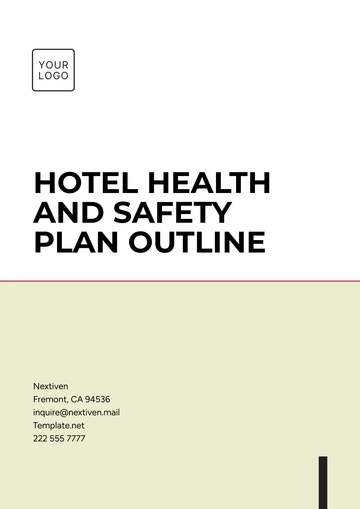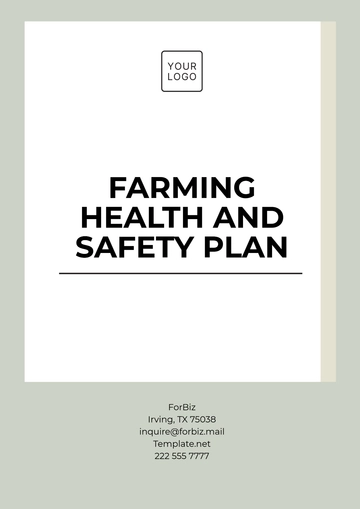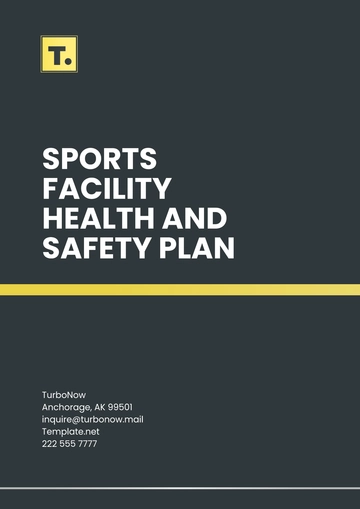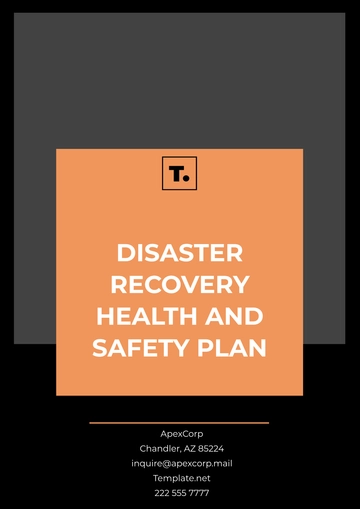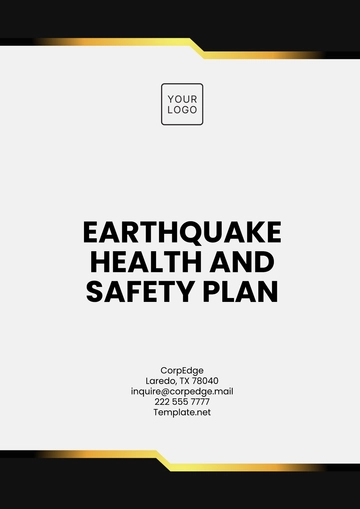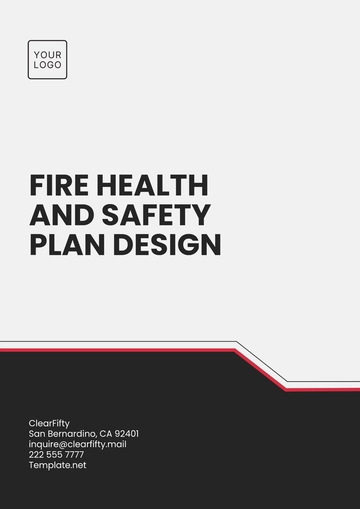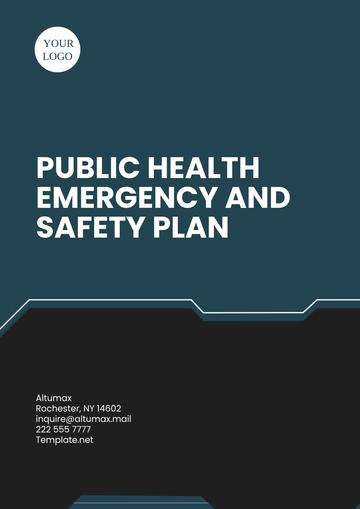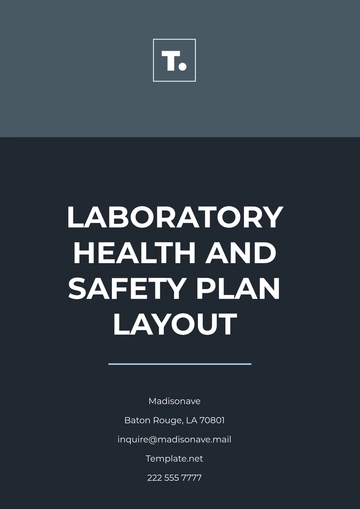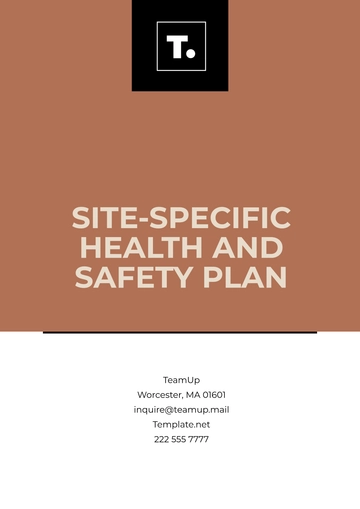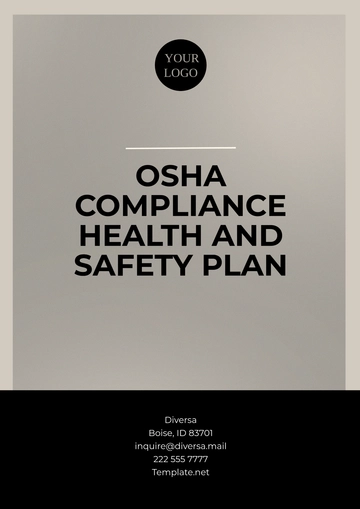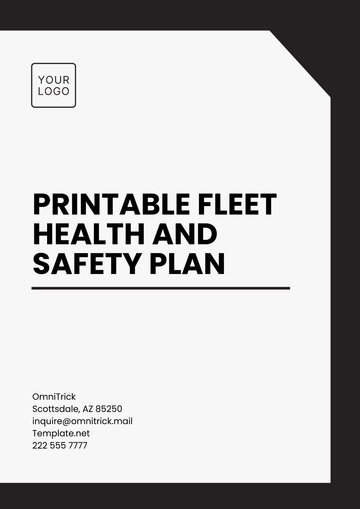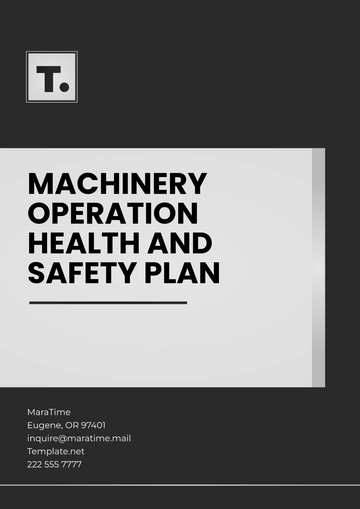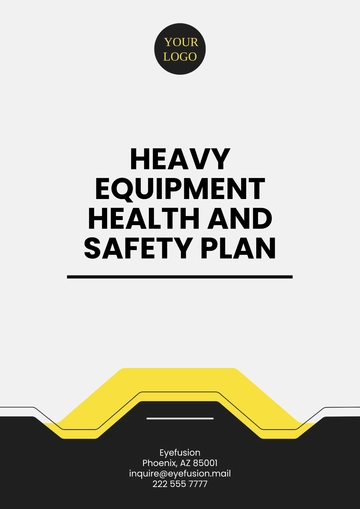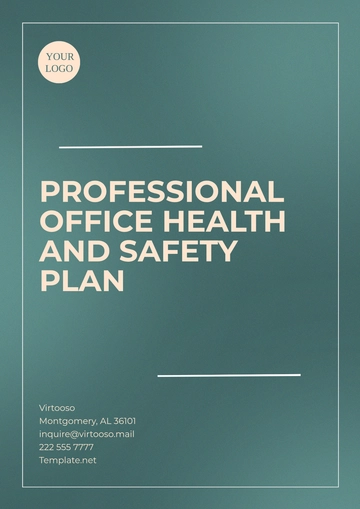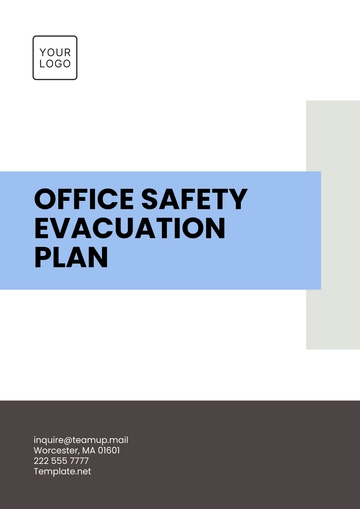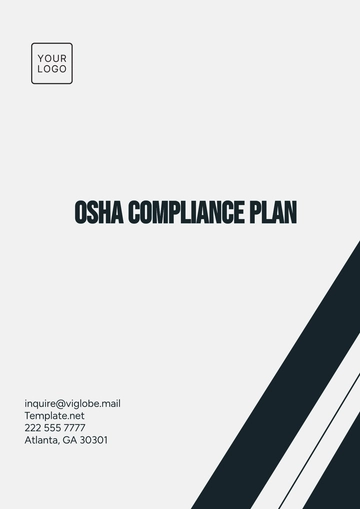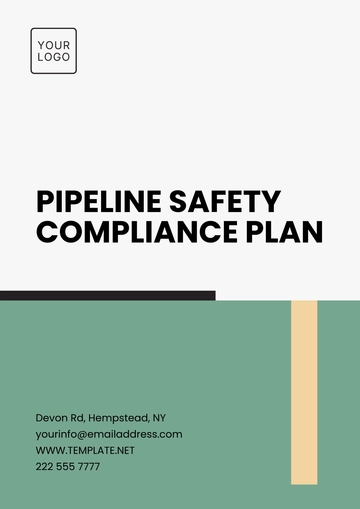Free Health & Safety Strategic Compliance Implementation Plan
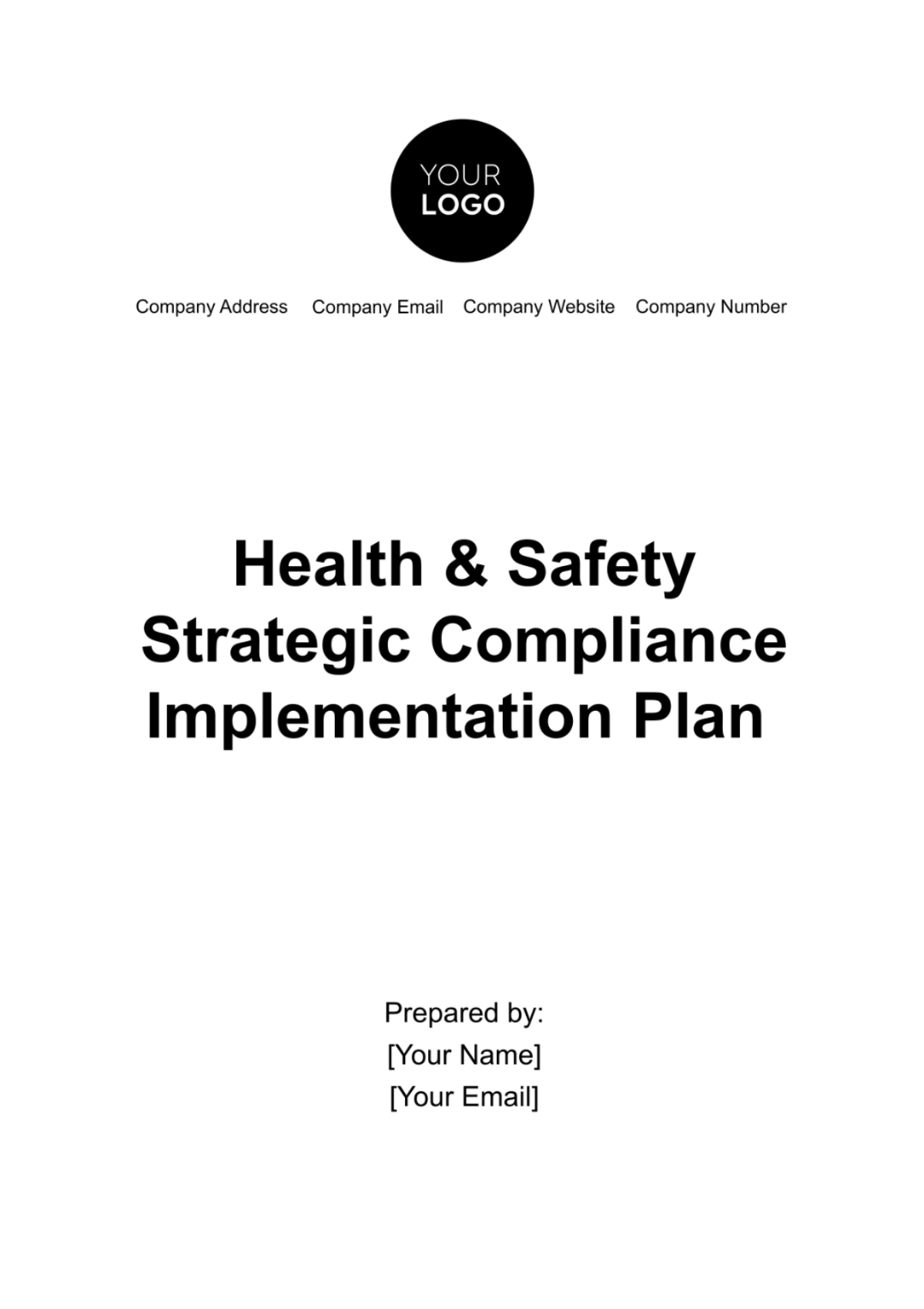
I. EXECUTIVE SUMMARY
The Health and Safety Strategic Compliance Implementation Plan for [Your Company Name] is designed to ensure a comprehensive approach to workplace safety and compliance with health and safety regulations. This document outlines a detailed strategy for implementing, monitoring, and continually improving health and safety practices across all operations of the company.
The plan spans various components, including policy development, risk assessment, employee training, emergency preparedness, and compliance monitoring. This provides a high-level overview of the plan's objectives, key initiatives, and expected outcomes.
II. INTRODUCTION
The importance of health and safety in the workplace cannot be overstated. As [Your Company Name] continues to grow and evolve, so too does the complexity of ensuring a safe working environment for all employees. This Health and Safety Strategic Compliance Implementation Plan represents our commitment to not just meet but exceed health and safety standards.
It is a testament to our dedication to providing a safe and healthy work environment, which is essential for the well-being of our employees and the success of our business. This plan is tailored to address the unique risks and challenges faced by our company and is designed to be dynamic, adapting to new regulations and best practices in health and safety.
III. PLAN OBJECTIVES
The Health & Safety Strategic Compliance Implementation Plan for [Your Company Name] is designed with a set of critical objectives, aiming to establish a robust, compliant, and proactive safety culture within the organization. The primary objectives of this plan are:
A. Establish and Reinforce a Robust Health and Safety Policy
This focuses on developing a comprehensive health and safety policy that is not only in alignment with current laws and regulations but also reflects the unique needs and risks of our workplace. The policy will serve as the foundation of our health and safety program, providing clear guidelines and procedures for all employees.
B. Conduct Comprehensive Risk Assessments
The goal here is to systematically identify potential hazards in the workplace and evaluate the associated risks. This process involves analyzing various work environments and operations to pinpoint areas of concern, including potential physical, chemical, biological, and ergonomic hazards. The outcome of these assessments will guide the development of targeted strategies to mitigate identified risks, thereby reducing the likelihood of workplace incidents and enhancing overall employee safety.
C. Implement Effective and Ongoing Training Programs
Implementing a dynamic and comprehensive training program is crucial to ensure that all employees are well-informed and skilled in health and safety practices. Training will cover a broad spectrum of topics, from basic safety procedures to specialized training for high-risk activities.
D. Develop and Maintain an Efficient Incident Reporting and Investigation System
Establishing a transparent and straightforward incident reporting system is vital to identify and address workplace hazards proactively. This system will encourage employees to report any safety concerns or incidents without fear of reprisal, creating an environment where safety is everyone's responsibility.
E. Regularly Review and Update Health and Safety Procedures
Regular reviews and updates of our safety protocols ensure that our practices not only comply with the latest regulations but also reflect the best practices in workplace safety. This ongoing process allows us to adapt to new challenges and technological advancements, ensuring that our approach to health and safety is both effective and forward-thinking.
IV. STRATEGIC INITIATIVES
In support of the Health & Safety Strategic Compliance Implementation Plan at [Your Company Name], the following strategic initiatives are proposed. These initiatives are designed to comprehensively address the key objectives laid out in the plan and ensure a robust, sustainable approach to health and safety within the organization.
A. Policy Development and Enforcement
Develop a comprehensive health and safety policy that reflects the company's commitment to a safe workplace. This policy will be communicated to all employees and will be enforced through regular audits and inspections. The policy will include specific protocols for hazard identification, risk management, and emergency response.
B. Risk Assessment and Management
Conduct detailed risk assessments in all areas of operation. These assessments will identify potential hazards and evaluate the risk they pose to employees' health and safety. Based on the assessments, appropriate risk mitigation strategies will be developed and implemented. These strategies will be regularly reviewed and updated to reflect changes in operations or regulations.
C. Employee Training and Awareness
Implement a comprehensive training program that covers all aspects of health and safety relevant to our operations. This program will include initial training for new employees, ongoing training for existing employees, and specialized training for employees in high-risk roles. The training will be designed to ensure that all employees are aware of the health and safety risks associated with their work and are competent in applying safety practices.
D. Incident Reporting and Investigation
Establish a clear and accessible system for reporting health and safety incidents. This system will encourage employees to report any incidents or near misses, ensuring that all potential hazards are identified and addressed. An investigation protocol will be developed to analyze incidents and implement corrective actions to prevent recurrence.
E. Compliance Monitoring and Continuous Improvement
Regularly monitor and review health and safety practices to ensure compliance with policies and regulations. This will involve periodic audits, inspections, and reviews of health and safety procedures. Feedback from employees will be sought to identify areas for improvement, and the plan will be updated accordingly to reflect best practices and regulatory changes.
V. IMPLEMENTATION TIMELINE
This timeline is essential for ensuring that the plan's objectives are achieved in a timely and organized manner.
Activity | Start Date | End Date | Responsible Department |
Policy Development | [MM-DD-YYYY] | [MM-DD-YYYY] | Human Resources |
Risk Assessment | [MM-DD-YYYY] | [MM-DD-YYYY] | Operations |
Training Program Implementation | [MM-DD-YYYY] | [MM-DD-YYYY] | Human Resources |
Incident Reporting System Setup | [MM-DD-YYYY] | [MM-DD-YYYY] | Health & Safety |
Compliance Audits | [MM-DD-YYYY] | [MM-DD-YYYY] | Compliance |
A. Policy Development
This phase involves creating a comprehensive health and safety policy. The Human Resources department leads the process, drafting the policy, incorporating feedback from various stakeholders, and ensuring it aligns with legal requirements and industry best practices.
B. Risk Assessment
During this stage, the Operations department conducts thorough risk assessments across different areas of the company. The process identifies potential hazards and assesses risks, leading to the development of mitigation strategies. The defined period covers the initial assessment phase through to the implementation of the initial risk mitigation measures.
C. Training Program Implementation
This ongoing activity involves the rollout and maintenance of comprehensive employee training programs. Human Resources is responsible for developing training materials, scheduling sessions, and ensuring employee participation. The timeline indicates the start of the training program, with an ongoing commitment to its execution and refinement.
D. Incident Reporting System Setup
The Health & Safety department is tasked with setting up an efficient incident reporting system. This phase includes developing procedures, creating reporting tools, and training employees on the new system.
E. Compliance Audits
Regular compliance audits are essential to ensure ongoing adherence to health and safety policies and regulations. The Compliance department oversees these audits, which are scheduled to start from a specific date and continue on a regular basis.
VI. IMPLEMENTATION STEPS
To ensure the successful execution of the Health & Safety Strategic Initiatives at [Your Company Name], the following implementation steps are proposed. These steps are designed to provide a structured and effective approach towards achieving the set objectives.
A. Policy Development and Enforcement
1. Draft a comprehensive health and safety policy, incorporating input from various departments and aligning with industry best practices.
2. Communicate the policy to all employees through multiple channels, including team meetings, email, and the company intranet.
3. Schedule regular training sessions to reinforce the policy and ensure understanding and compliance.
B. Risk Assessment and Management
1. Identify potential hazards in each department or area of operation through site visits, employee feedback, and historical data analysis.
2. Evaluate the severity and likelihood of identified hazards, prioritizing them based on their risk level.
3. Develop risk mitigation strategies, such as engineering controls, administrative controls, and personal protective equipment.
4. Regularly review and update the risk assessment to reflect changes in operations, processes, or regulations.
C. Employee Training and Awareness
1. Develop a training curriculum that covers essential health and safety topics, tailored to the specific needs of different roles within the company.
2. Schedule and conduct initial and refresher training sessions, utilizing a mix of in-person and online training methods to maximize reach and effectiveness.
3. Implement a tracking system to monitor employee training completion and competency.
4. Foster a culture of safety by involving employees in safety discussions, encouraging feedback, and recognizing safe behaviors.
D. Incident Reporting and Investigation
1. Implement an easy-to-use incident reporting system, accessible to all employees.
Develop clear guidelines for reporting incidents, including what to report, how to report, and the timelines for reporting.
2. Train employees on the importance of reporting and the procedures to follow.
Establish an investigation team to analyze reported incidents, identify root causes, and develop corrective actions.
E. Compliance Monitoring and Continuous Improvement
1. Schedule regular health and safety audits to assess compliance with internal policies and external regulations.
2. Review and analyze audit findings to identify trends and areas for improvement.
Update health and safety procedures and practices based on audit outcomes and employee feedback.
VII. CONCLUSION
The Health and Safety Strategic Compliance Implementation Plan for [Your Company Name] outlines a comprehensive and proactive approach to ensuring a safe and compliant workplace. Through careful planning, diligent implementation, and ongoing monitoring and improvement, we are committed to protecting our employees and fostering a culture of safety. This plan will be regularly reviewed and updated to ensure that it remains effective and relevant to our operations and industry standards.
- 100% Customizable, free editor
- Access 1 Million+ Templates, photo’s & graphics
- Download or share as a template
- Click and replace photos, graphics, text, backgrounds
- Resize, crop, AI write & more
- Access advanced editor
Secure your copy of Template.net's Health & Safety Strategic Compliance Implementation Plan Template today! Meticulously designed, this indispensable resource is editable and customizable, perfectly tailored to your company's distinct requirements. Essential for ensuring workplace compliance and safety, it's a must-have for businesses prioritizing responsible operations and employee well-being. Elevate your safety protocols effortlessly with this comprehensive template.
You may also like
- Finance Plan
- Construction Plan
- Sales Plan
- Development Plan
- Career Plan
- Budget Plan
- HR Plan
- Education Plan
- Transition Plan
- Work Plan
- Training Plan
- Communication Plan
- Operation Plan
- Health And Safety Plan
- Strategy Plan
- Professional Development Plan
- Advertising Plan
- Risk Management Plan
- Restaurant Plan
- School Plan
- Nursing Home Patient Care Plan
- Nursing Care Plan
- Plan Event
- Startup Plan
- Social Media Plan
- Staffing Plan
- Annual Plan
- Content Plan
- Payment Plan
- Implementation Plan
- Hotel Plan
- Workout Plan
- Accounting Plan
- Campaign Plan
- Essay Plan
- 30 60 90 Day Plan
- Research Plan
- Recruitment Plan
- 90 Day Plan
- Quarterly Plan
- Emergency Plan
- 5 Year Plan
- Gym Plan
- Personal Plan
- IT and Software Plan
- Treatment Plan
- Real Estate Plan
- Law Firm Plan
- Healthcare Plan
- Improvement Plan
- Media Plan
- 5 Year Business Plan
- Learning Plan
- Marketing Campaign Plan
- Travel Agency Plan
- Cleaning Services Plan
- Interior Design Plan
- Performance Plan
- PR Plan
- Birth Plan
- Life Plan
- SEO Plan
- Disaster Recovery Plan
- Continuity Plan
- Launch Plan
- Legal Plan
- Behavior Plan
- Performance Improvement Plan
- Salon Plan
- Security Plan
- Security Management Plan
- Employee Development Plan
- Quality Plan
- Service Improvement Plan
- Growth Plan
- Incident Response Plan
- Basketball Plan
- Emergency Action Plan
- Product Launch Plan
- Spa Plan
- Employee Training Plan
- Data Analysis Plan
- Employee Action Plan
- Territory Plan
- Audit Plan
- Classroom Plan
- Activity Plan
- Parenting Plan
- Care Plan
- Project Execution Plan
- Exercise Plan
- Internship Plan
- Software Development Plan
- Continuous Improvement Plan
- Leave Plan
- 90 Day Sales Plan
- Advertising Agency Plan
- Employee Transition Plan
- Smart Action Plan
- Workplace Safety Plan
- Behavior Change Plan
- Contingency Plan
- Continuity of Operations Plan
- Health Plan
- Quality Control Plan
- Self Plan
- Sports Development Plan
- Change Management Plan
- Ecommerce Plan
- Personal Financial Plan
- Process Improvement Plan
- 30-60-90 Day Sales Plan
- Crisis Management Plan
- Engagement Plan
- Execution Plan
- Pandemic Plan
- Quality Assurance Plan
- Service Continuity Plan
- Agile Project Plan
- Fundraising Plan
- Job Transition Plan
- Asset Maintenance Plan
- Maintenance Plan
- Software Test Plan
- Staff Training and Development Plan
- 3 Year Plan
- Brand Activation Plan
- Release Plan
- Resource Plan
- Risk Mitigation Plan
- Teacher Plan
- 30 60 90 Day Plan for New Manager
- Food Safety Plan
- Food Truck Plan
- Hiring Plan
- Quality Management Plan
- Wellness Plan
- Behavior Intervention Plan
- Bonus Plan
- Investment Plan
- Maternity Leave Plan
- Pandemic Response Plan
- Succession Planning
- Coaching Plan
- Configuration Management Plan
- Remote Work Plan
- Self Care Plan
- Teaching Plan
- 100-Day Plan
- HACCP Plan
- Student Plan
- Sustainability Plan
- 30 60 90 Day Plan for Interview
- Access Plan
- Site Specific Safety Plan
